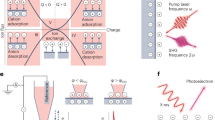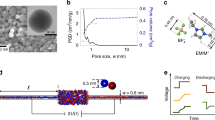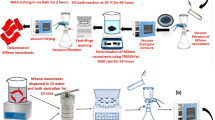Abstract
Electrosorption, the accumulation of electrolyte ions at charged interfaces, is a common phenomenon across various electrochemical systems. Its impact is particularly pronounced in nanoporous electrodes owing to their high surface-to-volume ratios. Although electrosorption alters the ion distribution at the electrode–electrolyte interface through the formation of an electrical double layer, the effects of electrosorbed ions on the charge storage dynamics in nanoporous electrodes and their ability to improve charging processes have often been overlooked. Here we use a multilayered reduced graphene oxide-based membrane as a model nanoporous electrode material, integrating numerical simulations with experimental insights. We monitor the spatiotemporal distribution of electrosorbed ions and electrical potentials across the nanopore network during fast charging of symmetrical laboratory-scale cells using aqueous and non-aqueous electrolyte solutions. This method allowed us to quantitatively assess how features of the nanoporous electrode mesostructure, such as nanoslit size, the distribution of nanoslit sizes and electrode thickness, dynamically influence ion electrosorption and the local electrical and chemical potentials across the network. Our findings reveal that the mesostructure of nanoporous electrodes influences how migration and diffusion currents, mediated by electrosorbed ions, respond to charging rates.
This is a preview of subscription content, access via your institution
Access options
Access Nature and 54 other Nature Portfolio journals
Get Nature+, our best-value online-access subscription
$32.99 / 30 days
cancel any time
Subscribe to this journal
Receive 12 print issues and online access
$259.00 per year
only $21.58 per issue
Buy this article
- Purchase on SpringerLink
- Instant access to full article PDF
Prices may be subject to local taxes which are calculated during checkout




Similar content being viewed by others
Data availability
All data needed to evaluate the conclusions are available in the Article or Supplementary Information. Source data are provided with this paper.
References
Forse, A. C., Merlet, C., Griffin, J. M. & Grey, C. P. New perspectives on the charging mechanisms of supercapacitors. J. Am. Chem. Soc. 138, 5731–5744 (2016).
Simon, P. & Gogotsi, Y. Perspectives for electrochemical capacitors and related devices. Nat. Mater. 19, 1151–1163 (2020).
Liu, Y., Zhu, Y. & Cui, Y. Challenges and opportunities towards fast-charging battery materials. Nat. Energy 4, 540–550 (2019).
Armand, M. & Tarascon, J. M. Building better batteries. Nature 451, 652–657 (2008).
Gogotsi, Y. & Simon, P. True performance metrics in electrochemical energy storage. Science 334, 917–918 (2011).
Choi, C. et al. Achieving high energy density and high power density with pseudocapacitive materials. Nat. Rev. Mater. 5, 5–19 (2019).
Bard, A. J., Faulkner, L. R. & White, H. S. Electrochemical Methods: Fundamentals and Applications (Wiley, 2022).
Aluru, N. R. et al. Fluids and electrolytes under confinement in single-digit nanopores. Chem. Rev. 123, 2737–2831 (2023).
O’Hayre, R., Cha, S.-W., Colella, W. & Prinz, F. B. Fuel Cell Fundamentals (Wiley, 2016).
Hu, Y. et al. Ultralow-resistance electrochemical capacitor for integrable line filtering. Nature 624, 74–79 (2023).
Robin, P. et al. Long-term memory and synapse-like dynamics in two-dimensional nanofluidic channels. Science 379, 161–167 (2023).
Pomerantseva, E., Bonaccorso, F., Feng, X., Cui, Y. & Gogotsi, Y. Energy storage: the future enabled by nanomaterials. Science 366, eaan8285 (2019).
Fleischmann, S. et al. Continuous transition from double-layer to Faradaic charge storage in confined electrolytes. Nat. Energy 7, 222–228 (2022).
Segalini, J., Daffos, B., Taberna, P. L., Gogotsi, Y. & Simon, P. Qualitative electrochemical impedance spectroscopy study of ion transport into sub-nanometer carbon pores in electrochemical double layer capacitor electrodes. Electrochim. Acta 55, 7489–7494 (2010).
Forse, A. C. et al. Direct observation of ion dynamics in supercapacitor electrodes using in situ diffusion NMR spectroscopy. Nat. Energy 2, 16216 (2017).
Shao, H., Wu, Y. C., Lin, Z., Taberna, P. L. & Simon, P. Nanoporous carbon for electrochemical capacitive energy storage. Chem. Soc. Rev. 49, 3005–3039 (2020).
Wang, X. et al. Electrode material–ionic liquid coupling for electrochemical energy storage. Nat. Rev. Mater. 5, 787–808 (2020).
Liu, X. et al. Structural disorder determines capacitance in nanoporous carbons. Science 384, 321–325 (2024).
Newman, J. S. & Tobias, C. W. Theoretical analysis of current distribution in porous electrodes. J. Electrochem. Soc. 109, 1183 (1962).
Newman, J. & Tiedemann, W. Porous‐electrode theory with battery applications. AlChE J. 21, 25–41 (2004).
Dunn, D. & Newman, J. Predictions of specific energies and specific powers of double-layer capacitors using a simplified model. J. Electrochem. Soc. 147, 820 (2000).
Anasori, B., Lukatskaya, M. R. & Gogotsi, Y. 2D metal carbides and nitrides (MXenes) for energy storage. Nat. Rev. Mater. 2, 16098 (2017).
Pomerantseva, E. & Gogotsi, Y. Two-dimensional heterostructures for energy storage. Nat. Energy 2, 17089 (2017).
Yang, X., Cheng, C., Wang, Y., Qiu, L. & Li, D. Liquid-mediated dense integration of graphene materials for compact capacitive energy storage. Science 341, 534–537 (2013).
Chen, W. et al. Two-dimensional quantum-sheet films with sub-1.2 nm channels for ultrahigh-rate electrochemical capacitance. Nat. Nanotechnol. 17, 153–158 (2022).
Xia, Y. et al. Thickness-independent capacitance of vertically aligned liquid-crystalline MXenes. Nature 557, 409–412 (2018).
Klemen, Z. et al. Derivation of transmission line model from the concentrated solution theory (CST) for porous electrodes. J. Electrochem. Soc. 168, 070543 (2021).
Meddings, N. et al. Application of electrochemical impedance spectroscopy to commercial Li-ion cells: a review. J. Power Sources 480, 228742 (2020).
Mei, B. A. et al. Physical interpretations of Nyquist plots for EDLC electrodes and devices. J. Phys. Chem. C 122, 194–206 (2018).
Sun, H. et al. Hierarchical 3D electrodes for electrochemical energy storage. Nat. Rev. Mater. 4, 45–60 (2018).
Gupta, A., Zuk, P. J. & Stone, H. A. Charging dynamics of overlapping double layers in a cylindrical nanopore. Phys. Rev. Lett. 125, 076001 (2020).
Pilon, L., Wang, H. & d’Entremont, A. Recent advances in continuum modeling of interfacial and transport phenomena in electric double layer capacitors. J. Electrochem. Soc. 162, A5158 (2015).
Biesheuvel, P. M. & Bazant, M. Z. Nonlinear dynamics of capacitive charging and desalination by porous electrodes. Phys. Rev. E 81, 031502 (2010).
Lin, Y., Lian, C., Berrueta, M. U., Liu, H. & van Roij, R. Microscopic model for cyclic voltammetry of porous electrodes. Phys. Rev. Lett. 128, 206001 (2022).
Mirzadeh, M., Gibou, F. & Squires, T. M. Enhanced charging kinetics of porous electrodes: surface conduction as a short-circuit mechanism. Phys. Rev. Lett. 113, 097701 (2014).
Dydek, E. V. et al. Overlimiting current in a microchannel. Phys. Rev. Lett. 107, 118301 (2011).
Levie, D. R. On porous electrodes in electrolyte solutions—IV. Electrochim. Acta 9, 1231–1245 (1964).
Li, P. et al. A review of compact carbon design for supercapacitors with high volumetric performance. Small 17, e2007548 (2021).
Shao, Y. et al. Design and mechanisms of asymmetric supercapacitors. Chem. Rev. 118, 9233–9280 (2018).
Li, Z. et al. Tuning the interlayer spacing of graphene laminate films for efficient pore utilization towards compact capacitive energy storage. Nat. Energy 5, 160–168 (2020).
Dou, Q. & Park, H. S. Perspective on high‐energy carbon‐based supercapacitors. Energy Environ. Sci. 3, 286–305 (2020).
Lukatskaya, M. et al. Ultra-high-rate pseudocapacitive energy storage in two-dimensional transition metal carbides. Nat. Energy 2, 17105 (2017).
Lu, X. et al. 3D microstructure design of lithium-ion battery electrodes assisted by X-ray nano-computed tomography and modelling. Nat. Commun. 11, 2079 (2020).
Wu, J. et al. Gradient design for high-energy and high-power batteries. Adv. Mater. 34, e2202780 (2022).
Zhang, Y. et al. Reducing the charge carrier transport barrier in functionally layer-graded electrodes. Angew. Chem. Int. Ed. 56, 14847–14852 (2017).
Ramadesigan, V., Methekar, R. N., Latinwo, F., Braatz, R. D. & Subramanian, V. R. Optimal porosity distribution for minimized ohmic drop across a porous electrode. J. Electrochem. Soc. 157, A1328–A1334 (2010).
Kilic, M. S., Bazant, M. Z. & Ajdari, A. Steric effects in the dynamics of electrolytes at large applied voltages. II. Modified Poisson-Nernst-Planck equations. Phys. Rev. E 75, 021503 (2007).
Gonella, G. et al. Water at charged interfaces. Nat. Rev. Chem. 5, 466–485 (2021).
Jiang, Y. et al. Surface diffusion enhanced ion transport through two-dimensional nanochannels. Sci. Adv. 9, eadi8493 (2023).
Cao, Y. et al. New structural insights into densely assembled reduced graphene oxide membranes. Adv. Funct. Mater. 32, 2201535 (2022).
Kovtyukhova, N. I. et al. Layer-by-layer assembly of ultrathin composite films from micron-sized graphite oxide sheets and polycations. Chem. Mater. 11, 771–778 (1999).
Hummers, W. S. & Offeman, R. E. Preparation of graphite oxide. J. Am. Chem. Soc. 80, 1339 (1958).
Cheng, C., Jiang, G., Simon, G. P., Liu, J. Z. & Li, D. Low-voltage electrostatic modulation of ion diffusion through layered graphene-based nanoporous membranes. Nat. Nanotechnol. 13, 685–690 (2018).
Cheng, C. et al. Ion transport in complex layered graphene-based membranes with tuneable interlayer spacing. Sci. Adv. 2, e1501272 (2016).
Wu, J. Understanding the electric double-layer structure, capacitance, and charging dynamics. Chem. Rev. 122, 10821–10859 (2022).
Liu, D. et al. Ion-specific nanoconfinement effect in multilayered graphene membranes: a combined nuclear magnetic resonance and computational study. Nano Lett. 23, 5555–5561 (2023).
Acknowledgements
We thank H. Zhan and Y. Wang for discussions. This work is supported by funding from the Australia Research Council (grant numbers FL180100029, IC180100049 and DP220103498 to D.L. and grant number FT220100149 to J.Z.L.).
Author information
Authors and Affiliations
Contributions
Conceptualization: D.L., P.W. and K.Z. Methodology and data analysis: P.W., K.Z., J.L., D.L. and J.Z.L. Investigation: P.W. and K.Z. Visualization: P.W. and J.L. Funding acquisition: D.L. Project administration: D.L. Supervision: D.L., J.Z.L. and G.P.S. Writing—original draft: P.W., D.L. Writing—review and editing: P.W., J.L., D.L., J.Z.L., G.P.S., K.Z. and X.W.
Corresponding authors
Ethics declarations
Competing interests
The authors declare no competing interests.
Peer review
Peer review information
Nature Nanotechnology thanks Kangkang Ge and the other, anonymous, reviewer(s) for their contribution to the peer review of this work.
Additional information
Publisher’s note Springer Nature remains neutral with regard to jurisdictional claims in published maps and institutional affiliations.
Supplementary information
Supplementary Information
Supplementary Note 1, Figs. 1–17, Tables 1 and 2 and references.
Source data
Source Data Fig. 1
Statistical source data.
Source Data Fig. 2
Statistical source data.
Source Data Fig. 3
Statistical source data.
Source Data Fig. 4
Statistical source data.
Rights and permissions
Springer Nature or its licensor (e.g. a society or other partner) holds exclusive rights to this article under a publishing agreement with the author(s) or other rightsholder(s); author self-archiving of the accepted manuscript version of this article is solely governed by the terms of such publishing agreement and applicable law.
About this article
Cite this article
Wang, P., Zhang, K., Liao, J. et al. Mesoscale dynamics of electrosorbed ions in fast-charging carbon-based nanoporous electrodes. Nat. Nanotechnol. 20, 1228–1236 (2025). https://doi.org/10.1038/s41565-025-01947-8
Received:
Accepted:
Published:
Issue date:
DOI: https://doi.org/10.1038/s41565-025-01947-8



